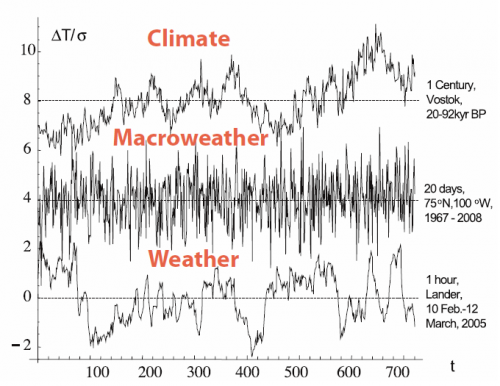Macroweather is what you expect

While short-term weather is notoriously volatile, climate is thought to represent a kind of average weather pattern over a long period of time. This dichotomy provides the analytical framework for scientific thinking about atmospheric variability, including climate change.
But the weather-climate dichotomy paints an incomplete picture – one that may be complicating efforts to untangle natural variations in climate from man-made effects, according to McGill University physics professor Shaun Lovejoy. In a paper published recently in the journal Eos, Transactions, American Geophysical Union, and in a forthcoming book, Lovejoy argues that statistical analysis shows there is a period between short-term weather and long-term climate that should be recognized as distinct.
Using the three-part atmospheric regime also makes the challenge of climate modeling more precise, and could open up a new set of approaches for modeling and predicting the climate, Lovejoy says.
Lovejoy used a new kind of "fluctuation analysis" to show that there are three atmospheric regimes, each with different types of variability. Between the weather (periods less than 10 days) and the climate (periods longer than about 30 to 100 years), there is an intermediate "macroweather" regime. A graphic representation makes the case intuitively clear.
The accompanying chart shows examples from weather (one-hour resolution, bottom), macroweather (20 days, middle) and climate (one century, top). The daily and annual cycles were removed and 720 consecutive points from each resolution are shown so that the differences in the characters of each regime are visually obvious.
At the bottom, the weather curve "wanders" up or down in a path resembling a drunkard's walk. In the middle, the macroweather curve has a markedly different character: upward fluctuations are typically followed by nearly cancelling downward ones. "The longer the period over which we average it, the smaller the variations become," Lovejoy says.
By contrast, the century scale climate curve (top) displays again a weather-like, wandering variability. (While this plot shows temperatures, other atmospheric fields – including wind, humidity and precipitation—are similar.)
Although the ultimate implications of macroweather may not be known for some time, a basic change in our understanding of what climate is will surely have repercussions, Lovejoy notes.
"Macroweather clarifies the distinction between natural and anthropogenic types of variability and allows us to separate the two with more confidence."
The old saying that "climate is what you expect, weather is what you get," also needs to be reconsidered, he adds. "Macroweather is what we expect."
More information: onlinelibrary.wiley.com/doi/10 … 002/2013EO010001/pdf
Provided by McGill University















